Jawaharlal Nehru Technological University Anantapur 2009 B.Tech Civil Engineering Jntu first - Question Paper
the attachment beneath is supplementery paper of fist year civil
Code No: Y0121/R07 Set No. 1
I B.Tech Supplementary Examinations, November 2009 APPLIED CHEMISTRY (Civil Engineering)
Time: 3 hours Max Marks: 80
Answer any FIVE Questions All Questions carry equal marks
i i i i i
1. (a) Discuss the method used for the estimation of chlorides.
(b) Calculate the hardness of water sample whose 10 ml required 20 ml of EDTA. 20 ml of calcium chloride solution, whose strength is equivalent to 105 g of CaCO3 per litre, required 30 ml of EDTA solution. [9+7]
2. (a) What are ion- exchange resins? How will you purify water by using them?
What are the advantages of this method over other methods.
(b) Explain the disadvantages of using hard water for various industries. [10+6]
3. (a) What is meant by differential aeration corrosion? Illustrate with suitable
examples.
(b) How is rate of corrosion influenced by
i. nature of corrosion product and
ii. relative anodic to cathodic areas
iii. Temperature and moisture. [8+8]
4. (a) Explain why Chromium plating has nickel under coat?
(b) Describe any two methods of Cathodic coating. [4+12]
5. (a) How is HDPE is prepared? Give its properties and uses?
(b) Explain the injection moulding process with a neat diagram? Mention its advantages. [8+8]
6. (a) List the characteristics of electrical insulators.
(b) Detail out acidic and neutral refractories and its uses. [6+10]
7. (a) With a neat diagram explain the determination of viscosity of lubricant by
Redwood viscometer. What is it, impoartance?
(b) Explain how flash & fire point is determined using Pensky-Marten apparatus. What is their importance? [8+8]
8. What are the chemical constituents of Cement? Discuss the function of each constituent. [16]
iiiii
I B.Tech Supplementary Examinations, November 2009 APPLIED CHEMISTRY (Civil Engineering)
Time: 3 hours Max Marks: 80
Answer any FIVE Questions All Questions carry equal marks
1. (a) What is the principle of EDTA method? Explain the estimation of hardness
of water by complexometric method.
(b) Mention the dis-advantages of using hard water for industrial purpose. [12+4]
2. (a) What are boiler scales? How their composition effects the boiler? What are
their ill effects? Discuss the measures for their prevention.
(b) Compare the lime soda process with zeolite process of water softening. [8+8]
3. (a) Explain the mechanism of hydrogen evolution and oxygen absorption in elec
trochemical corrosion with an examples.
(b) How corrosion is controlled by material selection. [8+8]
4. (a) What is galvanization? Explain the process of galvanization, what are its
applications.
(b) Define throwing power? Explain the various factors affecting the uniformity of electrodeposit. [10+6]
5. Explain how the polymers are classified on the basis of their thermal behaviour and method of polymerization. Give one example for each class. [16]
6. (a) What is pyrometric cone equivalent? How it is be determined for a refractory?
What is it significance?
(b) Write a very short notes on [6+10]
i. Porosity
ii. Thermal Conductivity
iii. Dimensional Stability
iv. Strength.
7. (a) Distinguish between hydrodynamic lubrication and boundary lubrication.
(b) Distinguish between hydrodynamic lubrication and extreme pressure lubrication. [8+8]
8. Write short notes on [16]
(a) Soundness test
(b) Compressive strength test
(c) White Cement
(d) Acid-resistant Cement.
I B.Tech Supplementary Examinations, November 2009 APPLIED CHEMISTRY (Civil Engineering)
Time: 3 hours Max Marks: 80
Answer any FIVE Questions All Questions carry equal marks
1. (a) What is meant by sterilization of water? Explain how sterilization of water is
carried out by using chlorine and ozone.
(b) 0.28 g of CaCO3 was dissolved in dil.HCl and the solution made up to one litre with distilled water. 100 mL of the above solution required 28 mL of EDTA solution for titration. 100 mL of the water sample required 33 mL of same EDTA solution for titration. After boiling 100 mL of this water, cooling, filtering and then titration required 10 mL of EDTA solution. Calculate the temporary and permanent hardness of water. [9+7]
2. Distinguish between the following: [6+6+4]
(a) Scales and Sludges
(b) Soft water and demineralised water.
(c) Lime soda process and demineralization of water.
3. (a) Explain the following factors influencing the rate of corrosion.
i. Nature of corrosion product
ii. Position in electrochemical series
iii. pH.
(b) Differentiate between dry corrosion and wet corrosion. [8+8]
4. (a) Explain why Chromium plating has nickel under coat?
(b) Describe any two methods of Cathodic coating. [4+12]
5. (a) Write the properties and uses of different types of silicones.
(b) Write short notes on Elastomers. [8+8]
6. (a) Explain how dimensional stability and porosity affect the properties of refrac
tories.
(b) Describe the manufacture of refractory bricks. [8+8]
7. (a) With a neat diagram explain the determination of viscosity of lubricant by
Redwood viscometer. What is it, impoartance?
(b) Explain how flash & fire point is determined using Pensky-Marten apparatus. What is their importance? [8+8]
8. (a) Detail out setting and hardening of cement with necessary equations.
(b) What is meant by rapid setting cement? Mention its uses.
i i i i i
[12+4]
I B.Tech Supplementary Examinations, November 2009 APPLIED CHEMISTRY (Civil Engineering)
Time: 3 hours Max Marks: 80
Answer any FIVE Questions All Questions carry equal marks
1.
a
b
2.
3.
a
b
4.
c
Define carbonate and non carbonate hardness of water. Mention the various dis-advantages of hard water for domestic use.
What is meant by sterilization of water? Explain how sterilization of water is carried out by using chlorine and ozone. [6+10]
Discuss the disadvantages of using hard water for various industries.
Explain the factors responsible for the corrosion of a boiler. Discuss the measures for its prevention. [8+8]
What is galvanic series? How does it help to predict corrosion of metals and alloys? Give examples.
Compare the merits and demerits of sacrificial anode method and impressed currentmethod of protection. [8+8]
List the differences between anodic coating and cathodic coating.
How zinc coated on iron prevents corrosion?
Explain sand blasting method of surface preparation?
[8+4+4]
Write the properties and uses of different types of silicones. Write short notes on Elastomers.
5.
[8+8]
What is pyrometric cone equivalent? How it is be determined for a refractory? What is it significance?
Write a very short notes on [6+10]
i. Porosity
ii. Thermal Conductivity
iii. Dimensional Stability
iv. Strength.
7. (a) What are solid lubricants? Explain any two solid lubricants and where they are used.
6.
(b) Write short note on Aniline point.
[12+4]
(a) What are the different types of Portland Cement? Give its general composition.
(b) State the various reactions occurring in the rotary kiln during the manufacture of Cement. [8+8]
i i i i i
I B.Tech Supplementary Examinations, November 2009 APPLIED PHYSICS ( Common to Electrical & Electronic Engineering, Electronics & Communication Engineering, Computer Science & Engineering, Electronics & Instrumentation Engineering, Bio-Medical Engineering, Information Technology, Electronics & Control Engineering, Computer Science & Systems Engineering, Electronics & Computer Engineering, and Instrumentation & Control Engineering )
Time: 3 hours Max Marks: 80
Answer any FIVE Questions All Questions carry equal marks i i i i i
1. (a) What is Madelung constant? Explain.
(b) Describe the 3-dimensional Bravais lattices in combination with crystal systems.
(c) X-rays of wavelength 1.51 A are incident on a crystal face having an inter-planar spacing of 1.62 A. Find the highest order for which Braggs reflection maximum can be seen. [4+8+4]
2. (a) Show that the wavelength (A ) of an electron having mass (m) and kinetic
energy (E) is given by A
h
/2mE
(b) Derive time independent, one-dimensional Schrodinger wave equation.
(c) Find the lowest energy of an electron confined to a one-dimensional cubical box of side 0.1 nm each. [6+6+4]
3. (a) Distinguish between classical free electron theory and quantum free electron
theory of metals.
(b) Explain the Fermi-Dirac distribution function of electrons. Explain the effect of temperature on the distribution. [8+8]
4. (a) Explain the terms:
i. Magnetic flux density
ii. Magnetic field strength
iii. Magnetization and
iv. Magnetic susceptibility. How they are related to each other?
(b) Explain the origin of magnetic moment. Find the magnetic dipole moments due to orbital and spin motions of an electron.
(c) A magnetic field of 1800 amp/m produces a magnetic flux of 3 x 10-5 wb in an iron bar of cross-sectional area 0.2 cm2.Calculate the permeability. [6+6+4]
5. (a) Explain the terms:
i. critical field
ii. critical temperature and
iii. critical current density, relating to superconductivity.
Give the relation between critical field and critical temperature.
(b) Distinguish between DC and AC Josephson effects.
[8+8]
6. (a) Distinguish between spontaneous emission and stimulated emission.
(b) Explain the following terms:
i. Life time of an energy level
ii. Optical pumping,
iii. Metastable state and
iv. Active medium of a laser system.
(c) Explain the medical applications of lasers. [6+6+4]
7. (a) Describe the construction of a typical optical fiber and give the dimensions of
the various parts.
(b) Define acceptance angle and numerical aperture. Obtain an expression for the numerical aperture of an optical fiber.
(c) Calculate the numerical aperture and acceptance angle for an optical fiber with core and cladding refractive indices being 1.48 and 1.45 respectively. [6+6+4]
8. (a) What are nanomaterials? Explain.
(b) How the physical and chemical properties of nano-particles vary with their
size?
I B.Tech Supplementary Examinations, November 2009 APPLIED PHYSICS ( Common to Electrical & Electronic Engineering, Electronics & Communication Engineering, Computer Science & Engineering, Electronics & Instrumentation Engineering, Bio-Medical Engineering, Information Technology, Electronics & Control Engineering, Computer Science & Systems Engineering, Electronics & Computer Engineering, and Instrumentation & Control Engineering )
Time: 3 hours Max Marks: 80
Answer any FIVE Questions All Questions carry equal marks
1. (a) Explain the different types of bonding in solids with suitable examples.
(b) The distance between (1 1 0) planes in a body centered cubic structure is 0.203 nm. Calculate the size of the unit cell, and the radius of the atom. [12+4]
2. (a) Derive one-dimensional, time independent Schrodinger wave equation for an
electron.
(b) What is the physical significance of wave function?
(c) An electron is confined to a box of length 10-8m. Calculate the minimum uncertainty in velocity. [8+4+4]
3. (a) Explain the terms
i. mean free path
ii. relaxation time
iii. drift velocity and
iv. mobility of an electron in a metal.
(b) Discuss the various drawbacks of classical free electron theory of metals and explain the assumptions made in quantum theory to overcome the drawbacks.
[8+8]
4. (a) Explain the terms:
i. Magnetic flux density
ii. Magnetic field strength
iii. Magnetization and
iv. Magnetic susceptibility. How they are related to each other?
(b) Explain the origin of magnetic moment. Find the magnetic dipole moments due to orbital and spin motions of an electron.
(c) A magnetic field of 1800 amp/m produces a magnetic flux of 3 x 10-5 wb in an iron bar of cross-sectional area 0.2 cm2.Calculate the permeability. [6+6+4]
5. (a) How are superconductors classified? Explain their properties.
b
[6+4+6]
c
6
What is Meissner effect? Explain.
Write notes on the applications of superconducting materials. Explain the characteristics of a LASER.
Describe the construction and working of a homo-junction semiconductor diode laser.
Write any four applications of laser. [4+8+4]
c
Explain the principle of an optical fiber.
7
Explain how the optical fibers are classified.
Calculate the angle of acceptance of a given optical fiber, if the refractive indices of the core and the cladding are 1.563 and 1.498 respectively.[6+6+4]
c
Explain, in detail, the various properties of nanomaterials.
8.
What are carbon nanotubes? Explain. [12+4]
I B.Tech Supplementary Examinations, November 2009 APPLIED PHYSICS ( Common to Electrical & Electronic Engineering, Electronics & Communication Engineering, Computer Science & Engineering, Electronics & Instrumentation Engineering, Bio-Medical Engineering, Information Technology, Electronics & Control Engineering, Computer Science & Systems Engineering, Electronics & Computer Engineering, and Instrumentation & Control Engineering )
Time: 3 hours Max Marks: 80
Answer any FIVE Questions All Questions carry equal marks i i i i i
1. (a) Explain the formation of an ionic crystal, with a suitable example.
(b) Derive an expression for the cohesive energy of an ionic crystal. [6+10]
2. (a) Write short notes on:
i. de Broglie hypothesis and
ii. Electron diffraction.
(b) Describe Davisson and Germer experiment in support of de Broglie's concept.
(c) Calculate the velocity and kinetic energy of an electron of wavelength 1.66 A.
[6+6+4]
3. (a) Explain the draw backs of classical free electron theory.
(b) Derive an expression for conductivity of a metal on the basis of quantum free electron theory.
(c) The relaxation time of electrons in a conductor at 300 K is equal to 1.99 x 10-14 sec. Determine the electrical conductivity of that conductor. [Concentration of electrons = 8.5 x 1028 per m3] [4+8+4]
4. (a) Explain the following:
i. Dielectric constant
ii. Electric susceptibility
iii. Electric Polarization and
iv. Polarizability.
(b) Derive an expression for the internal field in a dielectric material. [6+10]
5. (a) What is meant by superconductivity?
(b) What are Type-I and Type-II superconductors?
(c) Calculate the critical magnetic field of a superconductor at 4.2 K. Given that the critical temperature of the material is 7.18 K and the critical magnetic field at 0 K is 6.5 x 104 amp/m. [4+8+4]
6. (a) Distinguish between spontaneous emission and stimulated emission..
(b) Distinguish between homo-junction semiconductor laser and hetero-junction semiconductor laser.
(c) Calculate the wavelength of emitted radiation from GaAs which has a band gap of 1.44 eV. [4+8+4]
7. (a) Explain the terms numerical aperture and acceptance angle
(b) With the help of a suitable diagram explain the principle, construction and working of an optical fiber as a waveguide.
(c) An optical fiber has a core material of refractive index of 1.55 and cladding material of refractive index 1.50. The light is launched into it in air. Calculated its numerical aperture. [6+6+4]
8. (a) Explain, in detail, the various properties of nanomaterials.
(b) What are carbon nanotubes? Explain. [12+4]
I B.Tech Supplementary Examinations, November 2009 APPLIED PHYSICS ( Common to Electrical & Electronic Engineering, Electronics & Communication Engineering, Computer Science & Engineering, Electronics & Instrumentation Engineering, Bio-Medical Engineering, Information Technology, Electronics & Control Engineering, Computer Science & Systems Engineering, Electronics & Computer Engineering, and Instrumentation & Control Engineering )
Time: 3 hours Max Marks: 80
Answer any FIVE Questions All Questions carry equal marks
1. (a) Explain the different types of bonding in solids with suitable examples.
(b) The distance between (1 1 0) planes in a body centered cubic structure is 0.203 nm. Calculate the size of the unit cell, and the radius of the atom. [12+4]
2. (a) Show that the wavelength (A) of an electron having mass (m) and kinetic
energy (E) is given by A= 2 .
(b) Write a detailed note on Heisenberg's uncertainty principle.
(c) Calculate the de Broglie wavelength of neutron whose kinetic energy is two times the rest mass of electron. [Mass of neutron = 1.676 x 10-27 Kg, Mass of electron = 9.1 x 10-31 Kg]. [6+6+4]
3. (a) Explain, in detail, Drude-Lorentz free electron theory of metals.
(b) Calculate the mobility and relaxation time of the electrons in silver. Also, calculate the electron drift velocity if the field intensity in the material is 1.0 V/cm. [Given resistivity of silver = 1.54 x 10-8 ohm-m at room temperature and electron density = 5.80 x 1028 per m3, Mass of electron = 9.1 x 10-31 Kg] [10+6]
4. (a) Explain the following:
i. Polarization vector and
ii. Electric displacement.
(b) Deduce an expression for Lorentz field relating to a dielectric material.
(c) The radius of the helium atom is 0.55 A.Calculate the polarizability of He and its relative permittivity. The number of He atoms in a volume of one metre cube is 2.70 x 1025 atoms. [permittivity of free space = 8.85 x10-12 F/m]
[4+8+4]
5. (a) How are superconductors classified? Explain their properties.
(b) What is Meissner effect? Explain.
(c) Write notes on the applications of superconducting materials. [6+4+6]
6. (a) What is population inversion relating to laser action? Explain.
(b) Distinguish between homo-junction semiconductor laser and hetero-junction semiconductor laser.
(c) A semiconductor diode laser has a peak emission wavelength of 1.55 m. Find its band gap in eV. [4+8+4]
7. (a) Describe the structure of an optical fiber.
(b) Explain, in detail, attenuation in optical fibers. [6+10]
8. (a) How the physical and chemical properties of nano-particles vary with their
size?
(b) Write the important applications of nanomaterials. [10+6]
I B.Tech Supplementary Examinations, November 2009 CLASSICAL MECHANICS ( Common to Mechanical Engineering, Chemical Engineering, Mechatronics, Production Engineering and Automobile Engineering)
Time: 3 hours Max Marks: 80
Answer any FIVE Questions All Questions carry equal marks
1. A rod AB shown in Figure 1 is held by a ball and socket joint at A and supports a mass C weighing 1200 N at end B. The rod is in x-y plane and is inclined to y axis at an angle of 150. The rod is 10 m long and has negligible weight. Find the forces in the cables DF and EB. [16]
|
z |
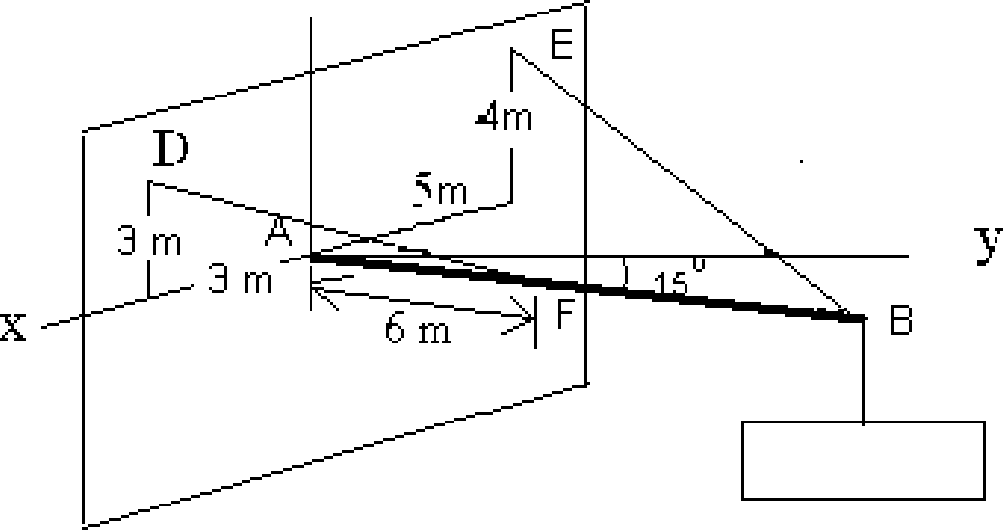 |
|
Figure 1 |
2. Five strings are tied at a point and are pulled in all directions, equally spaced, from one another. If the magnitude of the pulls on three consecutive strings is 70 N, 40 N and 55 N respectively, find graphically the magnitude of the pulls on two other strings, if the system is in equilibrium. [16]
3. Determine the volume of the body shown in figure 3 using Pappus-Guldinus theorem.
[16]
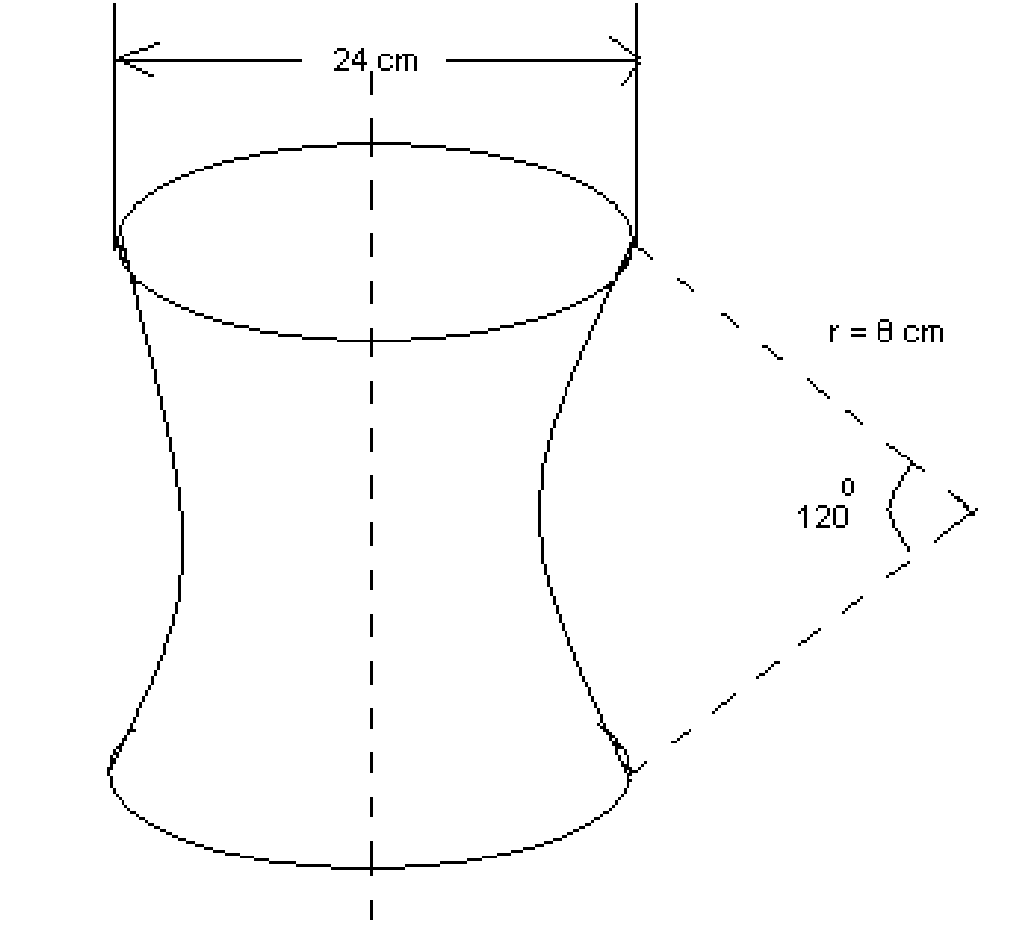 |
|
Figure 3 |
4. Find the product of inertia about X and Y axes of the area as shown in figure 4.
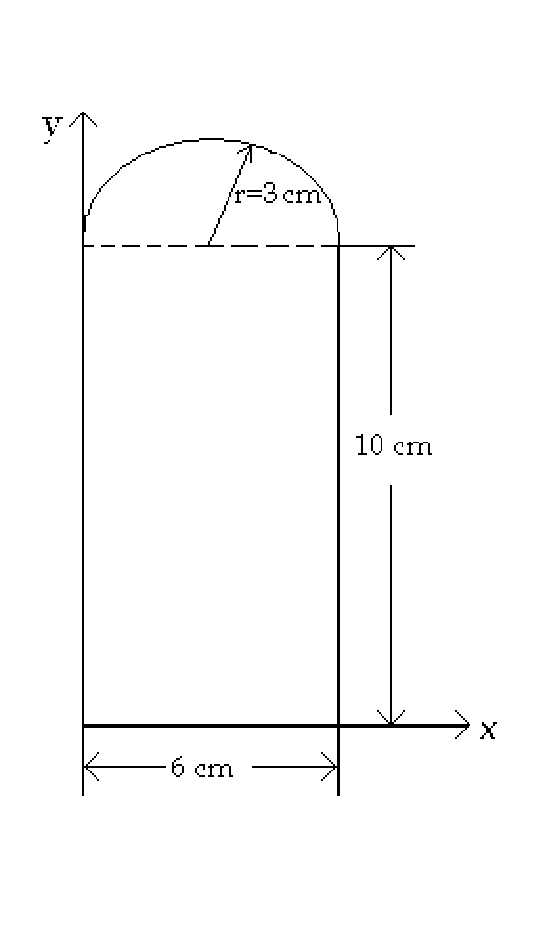 |
|
Figure 4 |
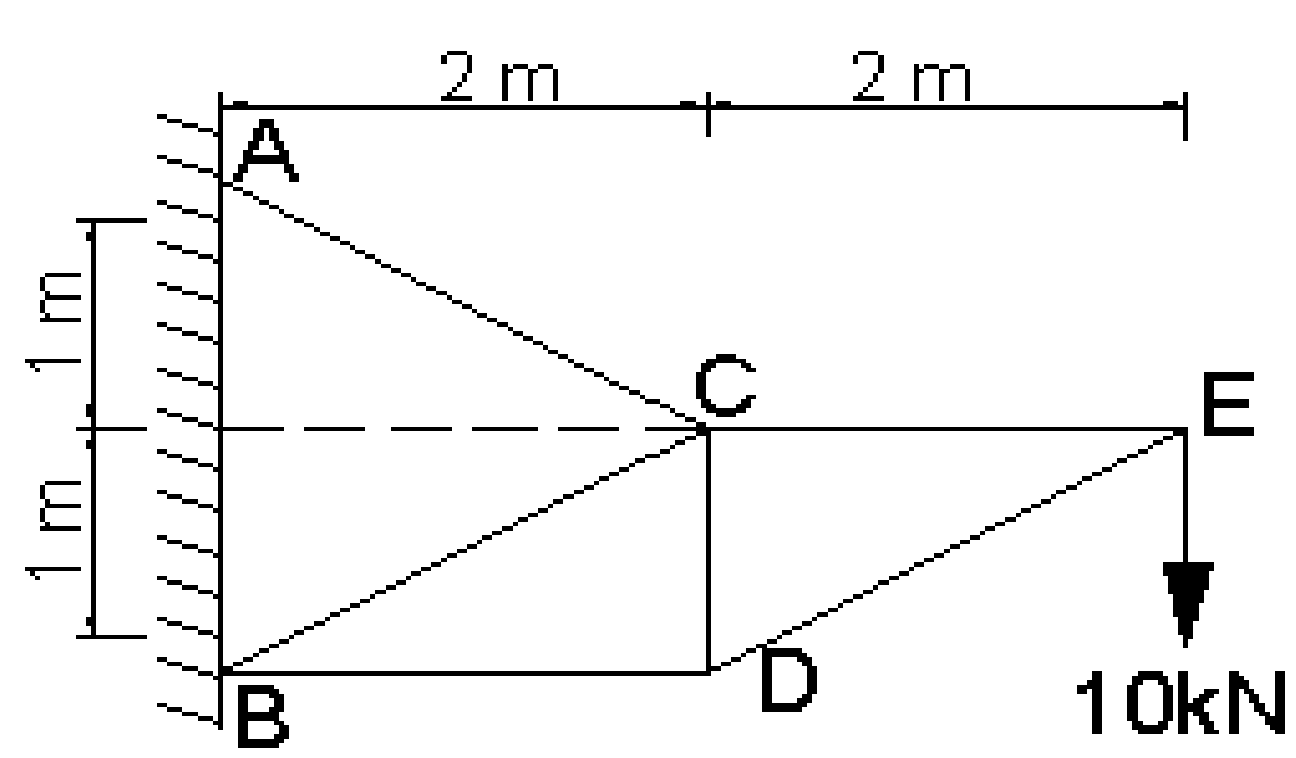 |
|
Figure 5b |
6. A helicopter is descending vertically downward with a uniform velocity. At a certain instant, a food packet is dropped from it which takes 6 secs to reach the ground. As this packet strikes the ground, another food packet is dropped from it, which takes 5 secs to reach he ground. Find the velocity with which the helicopter is descending and its height, when second packet is dropped. Also find the distance traveled by the helicopter during the interval of dropping the packets. [16]
7. A bullet is fired straight up from the surface of the moon with an initial velocity 620 m/s. Determine the mass elevation reached by the bullet.
(a) Assuming a uniform gravitational field with g = 1.782 m/s2
(b) using Newtons law of gravitation. (Radius of moon = 1750 km).
[16]
8. The central deflection of a simply supported beam with a central point load is given
by S = PL3 / 48EI. Where L = 5 M, E = 2 x101 N/mm2, I = 1.73 x 10 5 The beam is of uniform cross section with a static load P. Determine
m
(a) equivalent spring constant of the beam
(b) the frequency of vibration of a 60kg block attached to the centre of the beam. Neglect the mass of the beam and assume that the load remaining in contact with the beam. [16]
I B.Tech Supplementary Examinations, November 2009 CLASSICAL MECHANICS ( Common to Mechanical Engineering, Chemical Engineering, Mechatronics, Production Engineering and Automobile Engineering)
Time: 3 hours Max Marks: 80
Answer any FIVE Questions All Questions carry equal marks
|
1. Determine and locate the resultant R of the forces and one couple acting on the beam as shown in figure 1. [16] |
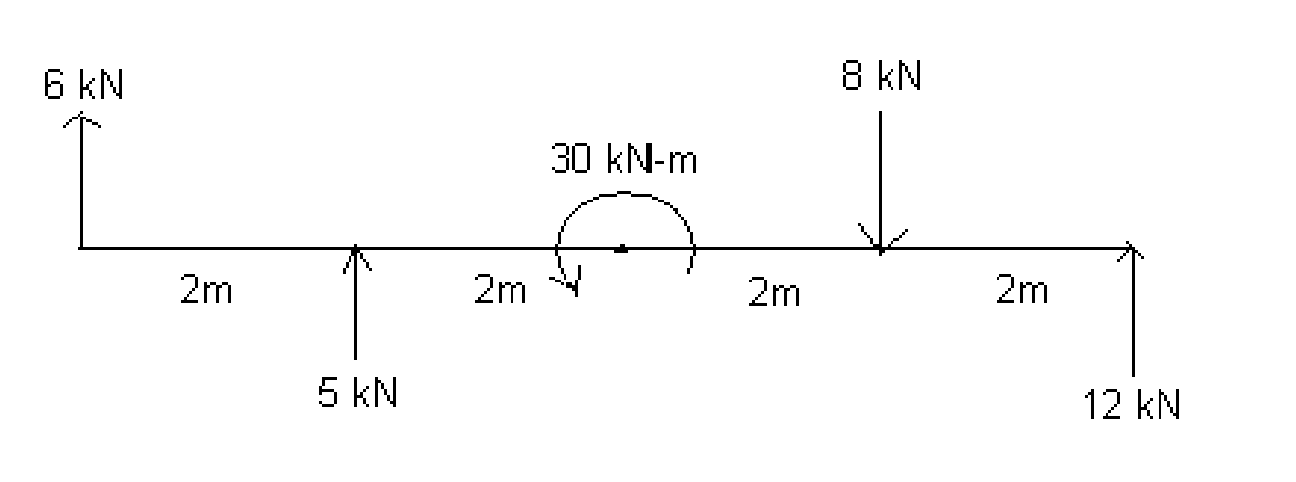 |
|
Figure 1 |
2. A force F with a magnitude of 150 N is applied at the origin O of the axes x, y and z as shown in Figure 2. The line of action of F passes through a point A whose co-ordinates are 2 m, 4 m and 6 m. Determine
(a) the x, y, and z scalar components of F
(b) the projection of F on x-y plane, and
(c) the projection of F along the line OB.
[16]
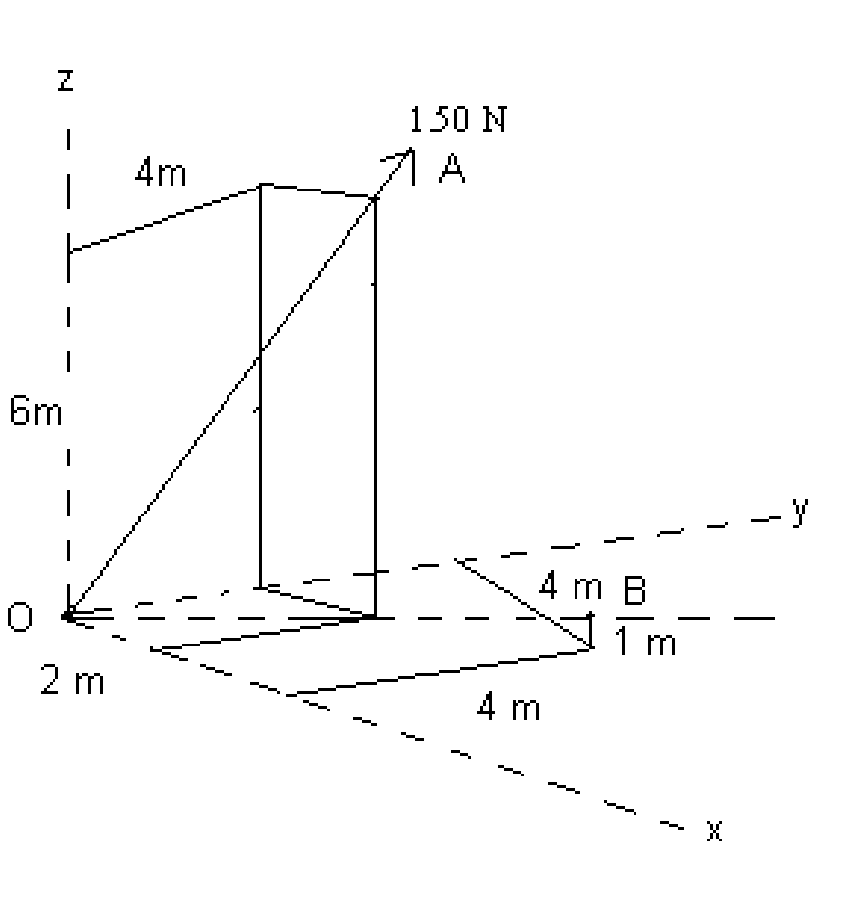
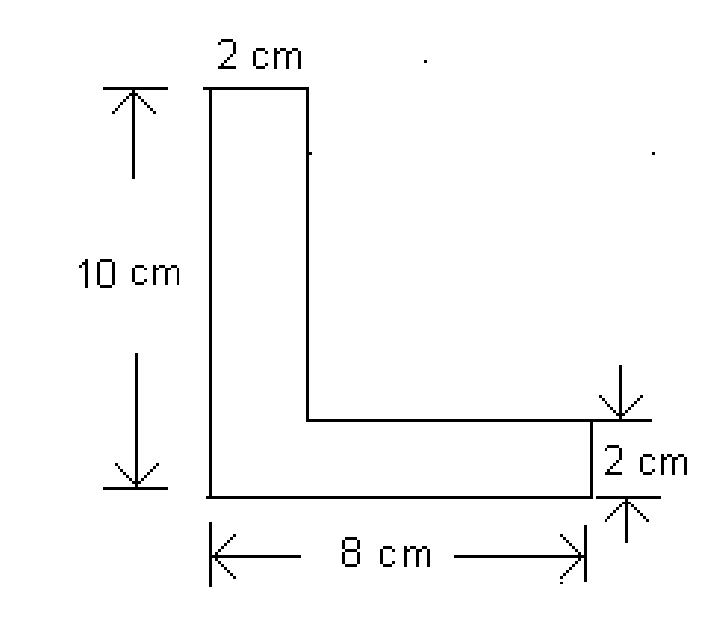
|
Figure 3a (b) Determine the Co-ordinates of the centroid of the shaped area OAB shown in figure 3b. [8+8] |
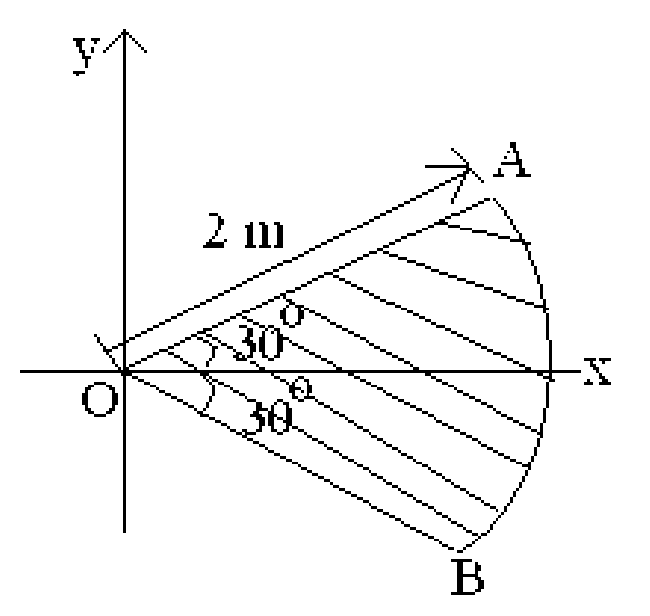 |
Figure 3b
3. (a) Find the centroid of the L section shown in figure 3a.
4. Calculate the moment of inertia of the L section shown in figure 4 with respect the controidal x-axis and y axis. [16]
| ||||||||||||
|
0 cm | ||||||||||||
T
10 cm 1
[16]
Figure 4
5. Find the axial forces in all the members of a truss shown in figure 5.
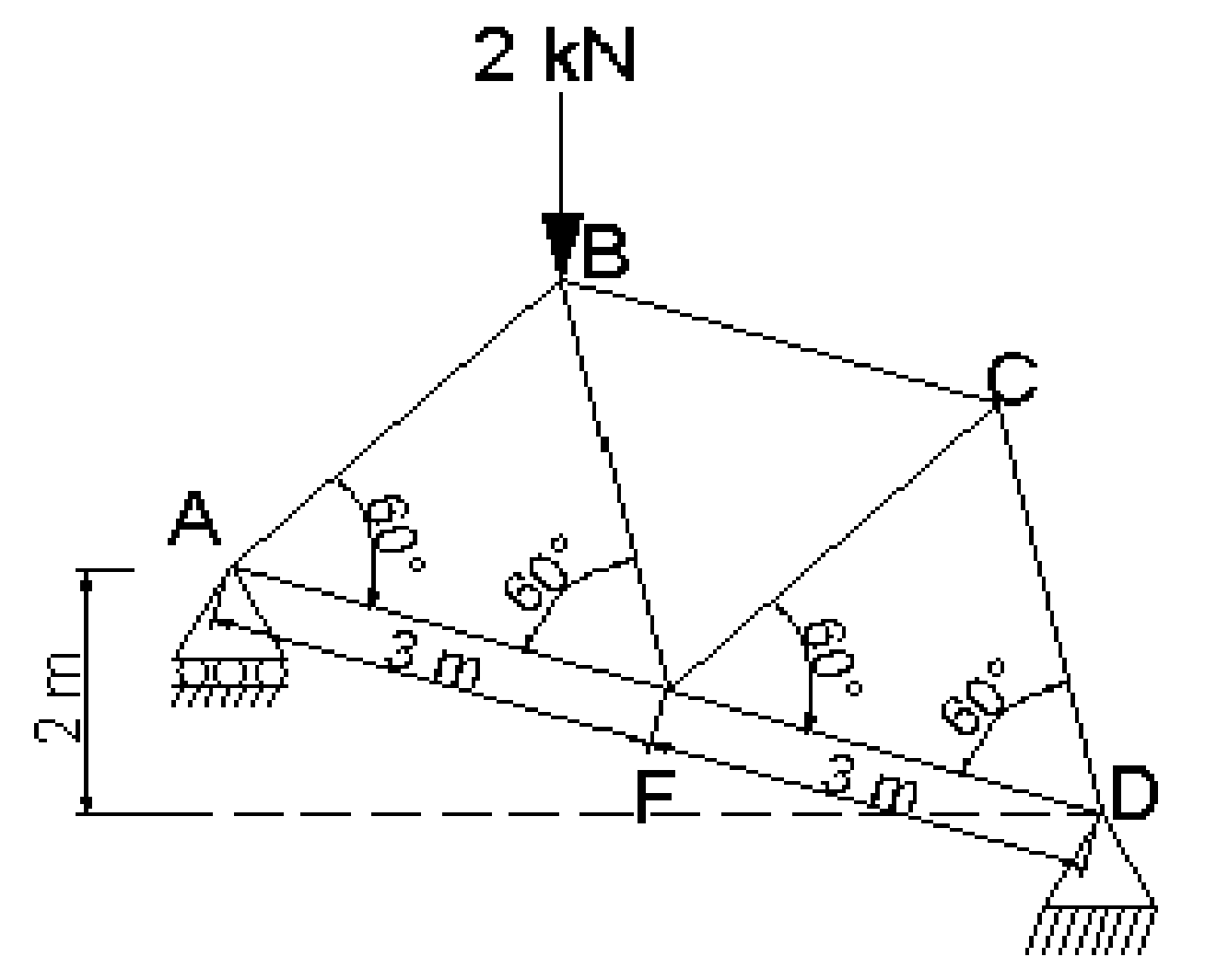 |
|
Figure 5 |
6. (a) Define curvilinear linear motion of a particle.
(b) Show that the system of the effective forces for a rigid slab in plane motion reduces to a single vector, and express the distance from the mass center G of the slab to the line of action of this vector in terms of the centroidal radius of gyration k of the slab, the magnitude a of the acceleration of G, and the angular acceleration a. [4+12]
7. (a) A 500kg communications satellite is in a circular geosynchronous orbit and
complete one revolution about the earth in 23 hrs and 58min at an attitude of 35800 km above the surface of the earth. The radius of the earth is 6510km. Determine the Kinetic energy of the satellite.
(b) Express the acceleration of gravity g at an altitude h above the surface of the earth in terms of the acceleration of gravity go. at the surface the earth, the altitude h, and the radius R of the earth. [8+8]
8. The central deflection of a simply supported beam with a central point load is given by S = PL3 / 48EI. Where L = 5 M, E = 2 x105 N/mm2, I = 1.73 x 10-5 m4. The beam is of uniform cross section with a static load P. Determine
(a) equivalent spring constant of the beam
(b) the frequency of vibration of a 60kg block attached to the centre of the beam. Neglect the mass of the beam and assume that the load remaining in contact with the beam. [16]
i i i i i
I B.Tech Supplementary Examinations, November 2009 CLASSICAL MECHANICS ( Common to Mechanical Engineering, Chemical Engineering, Mechatronics, Production Engineering and Automobile Engineering)
Time: 3 hours Max Marks: 80
Answer any FIVE Questions All Questions carry equal marks
(a) Four parallel forces of magnitudes 25 N, 50 N, 75 N and 100 N are shown in Figure 1a. Determine the magnitude of the resultant and also the distance of the resultant from point A.
1.
 |
|
Figure 1a (b) Two forces of 2kN and 5kN with an included angle of 300 between the lines of action act at a point A. Determine the magnitude and direction of the resultant. [8+8] |
2. A force F with a magnitude of 150 N is applied at the origin O of the axes x, y and z as shown in Figure 2. The line of action of F passes through a point A whose co-ordinates are 2 m, 4 m and 6 m. Determine
(a) the x, y, and z scalar components of F
(b) the projection of F on x-y plane, and
(c) the projection of F along the line OB.
[16]
3. Find the centroid of the area shown figure 3.
[16]
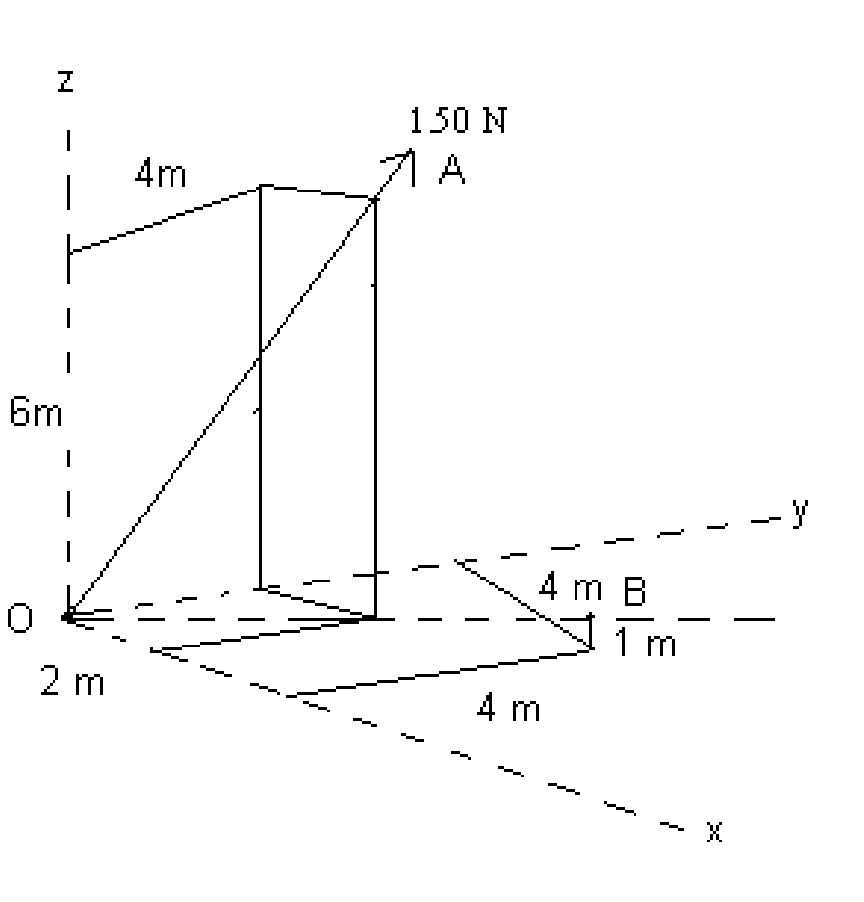 |
|
Figure 2 |
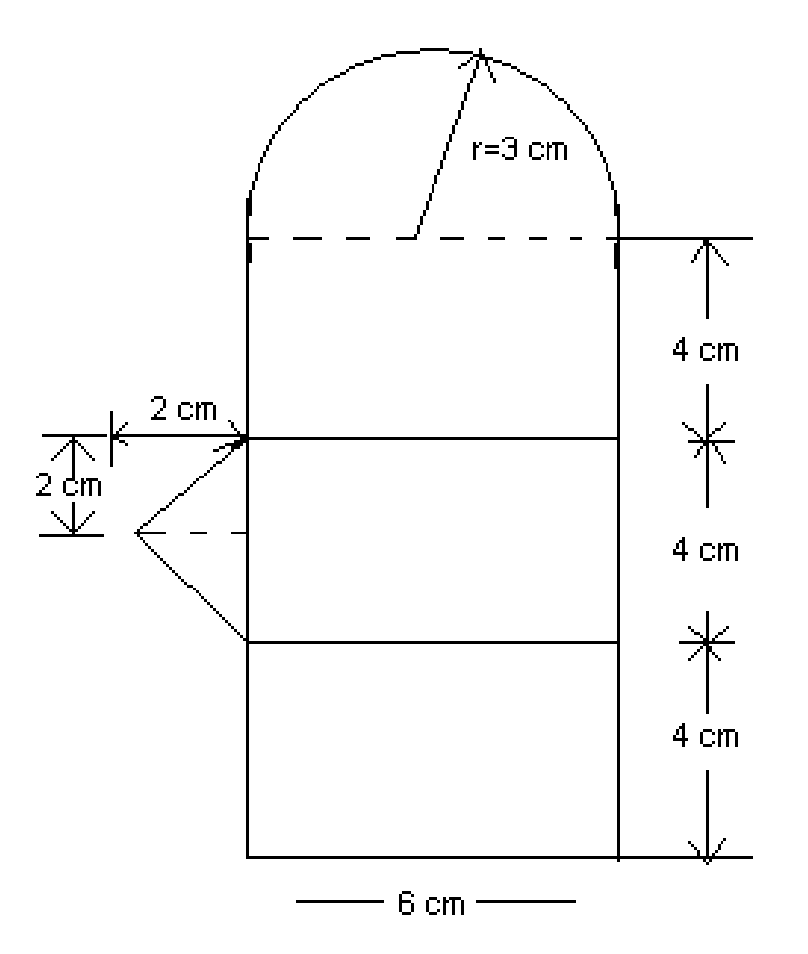 |
|
Figure 3 |
4. Find the moment of inertia of the plane area shown in figure 4 about X and Y axes through its centroid. [16]
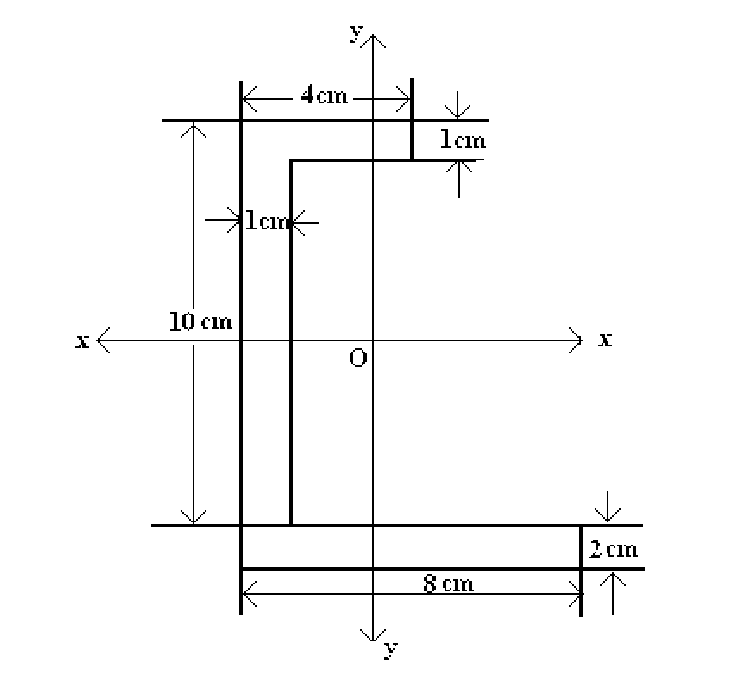 |
|
Figure 4 |
5. A pin jointed frame is supported at A and B and loaded as shown in figure 5. Find the forces in all the members of the frame and state in each case, whether the force is tensile or compressive. [16]
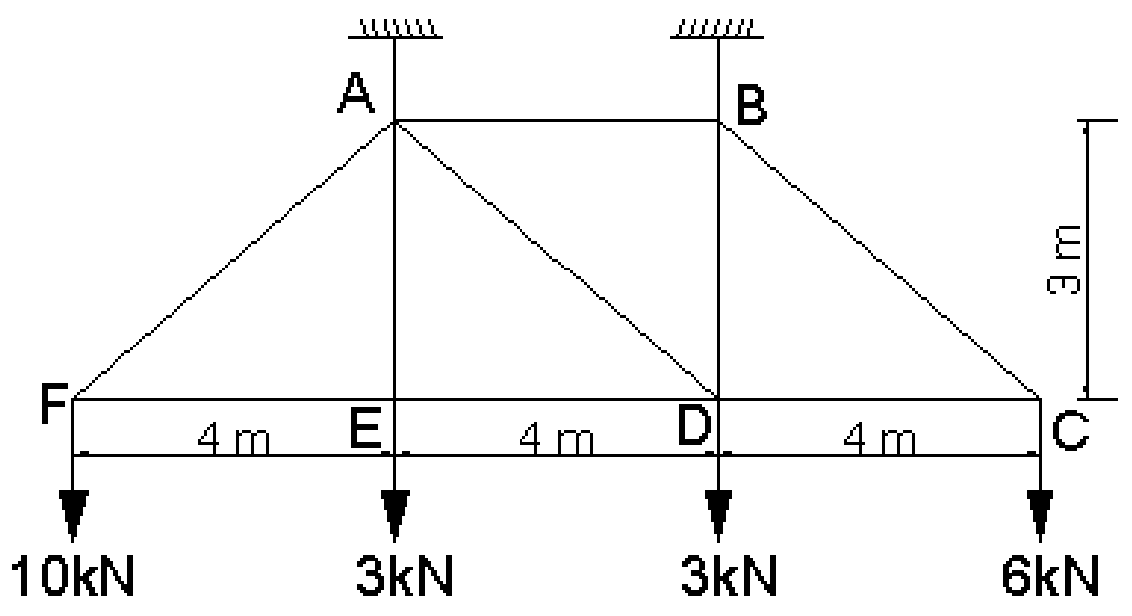 |
|
Figure 5 |
6. (a) What is the relation between initial velocity, final velocity and displacement
of a particle under the action of a constant force?
(b) A particle is projected to move along a parabola y2 = 4x. At a certain instant, when passing through a point P (4, 4) its speed is 5 m/S and the rate of increase of its speed is 3 m/S2 along the path. Express the velocity and acceleration of the particle in terms of rectangular coordinately. [6+10]
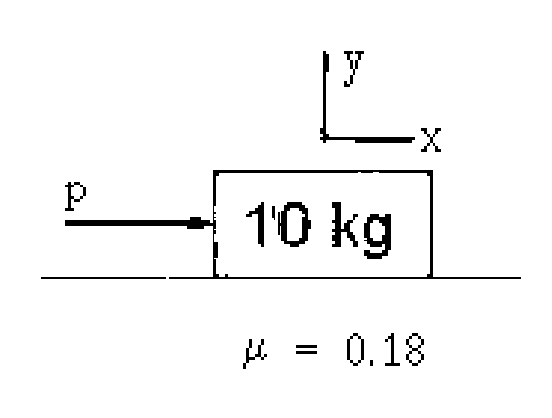 |
|
Figure 7 |
8. The central deflection of a simply supported beam with a central point load is given by S = PL3 / 48EI. Where L = 5 M, E = 2 x105 N/mm2, I = 1.73 x 10-5 m4. The beam is of uniform cross section with a static load P. Determine
(a) equivalent spring constant of the beam
(b) the frequency of vibration of a 60kg block attached to the centre of the beam. Neglect the mass of the beam and assume that the load remaining in contact with the beam. [16]
I B.Tech Supplementary Examinations, November 2009 CLASSICAL MECHANICS ( Common to Mechanical Engineering, Chemical Engineering, Mechatronics, Production Engineering and Automobile Engineering)
Time: 3 hours Max Marks: 80
Answer any FIVE Questions All Questions carry equal marks
1. A rod AB shown in Figure 1 is held by a ball and socket joint at A and supports a mass C weighing 1200 N at end B. The rod is in x-y plane and is inclined to y axis at an angle of 150. The rod is 10 m long and has negligible weight. Find the forces in the cables DF and EB. [16]
|
z |
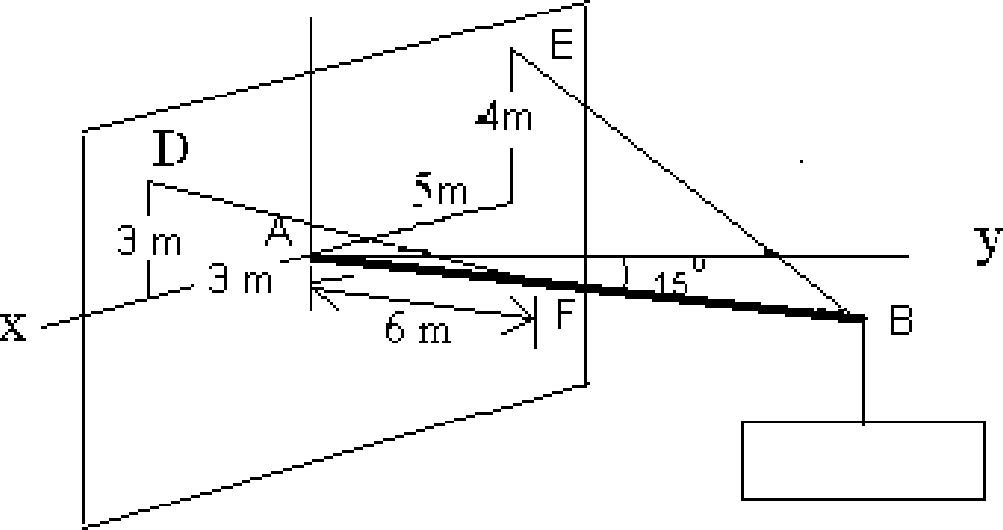 |
|
Figure 1 |
3. Find the centroid of the area shown figure 3.
[16]
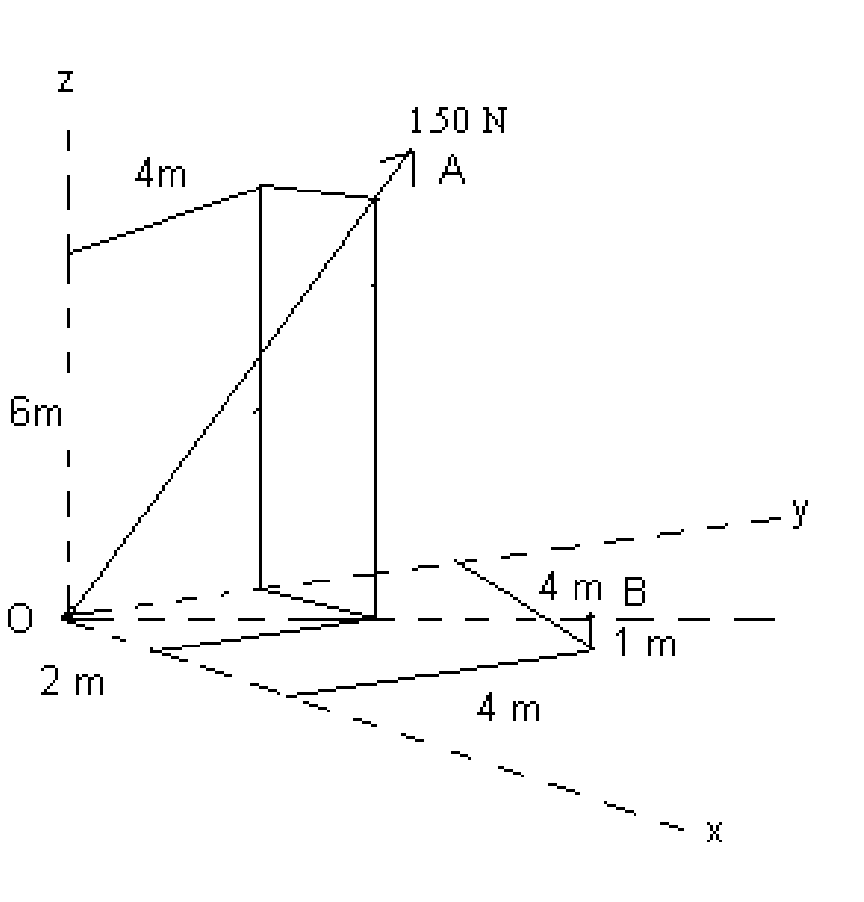 |
|
Figure 2 |
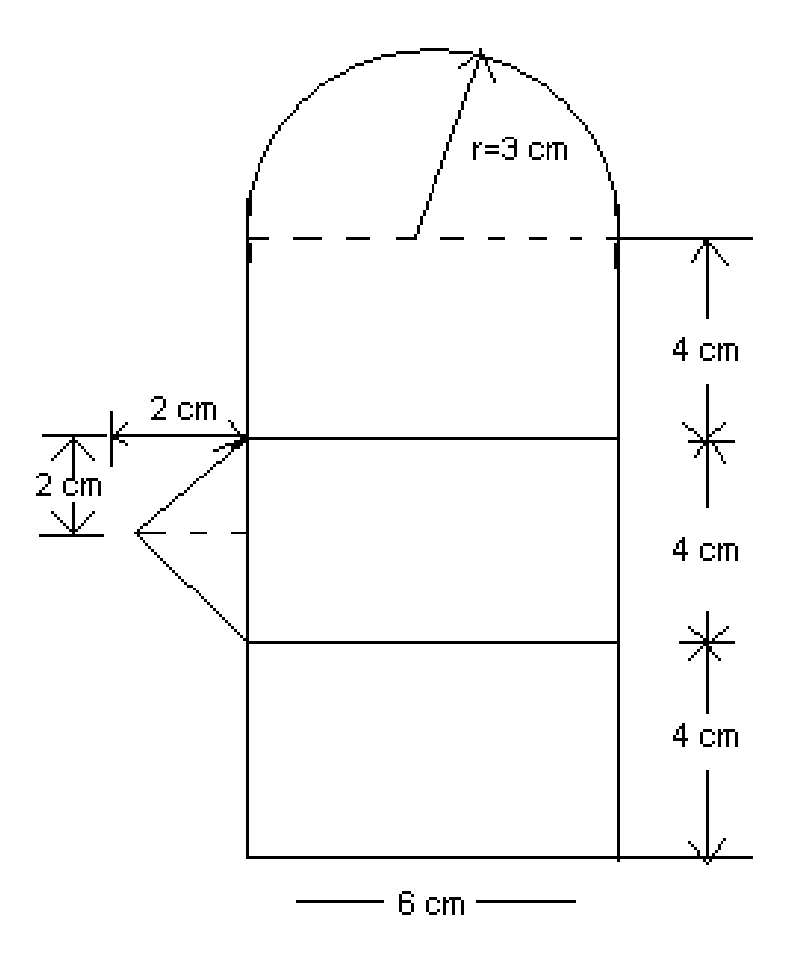 |
|
Figure 3 |
4. Find the moment of inertia of the plane area shown in figure 4 about X and Y axes through its centroid. [16]
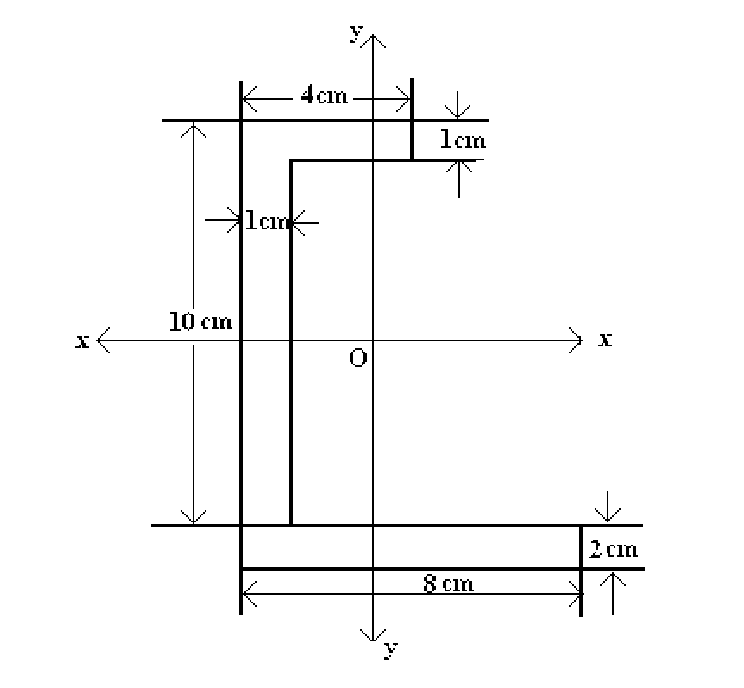 |
|
Figure 4 |
|
5. Find the axial forces in all the members of a truss shown in figure 5. |
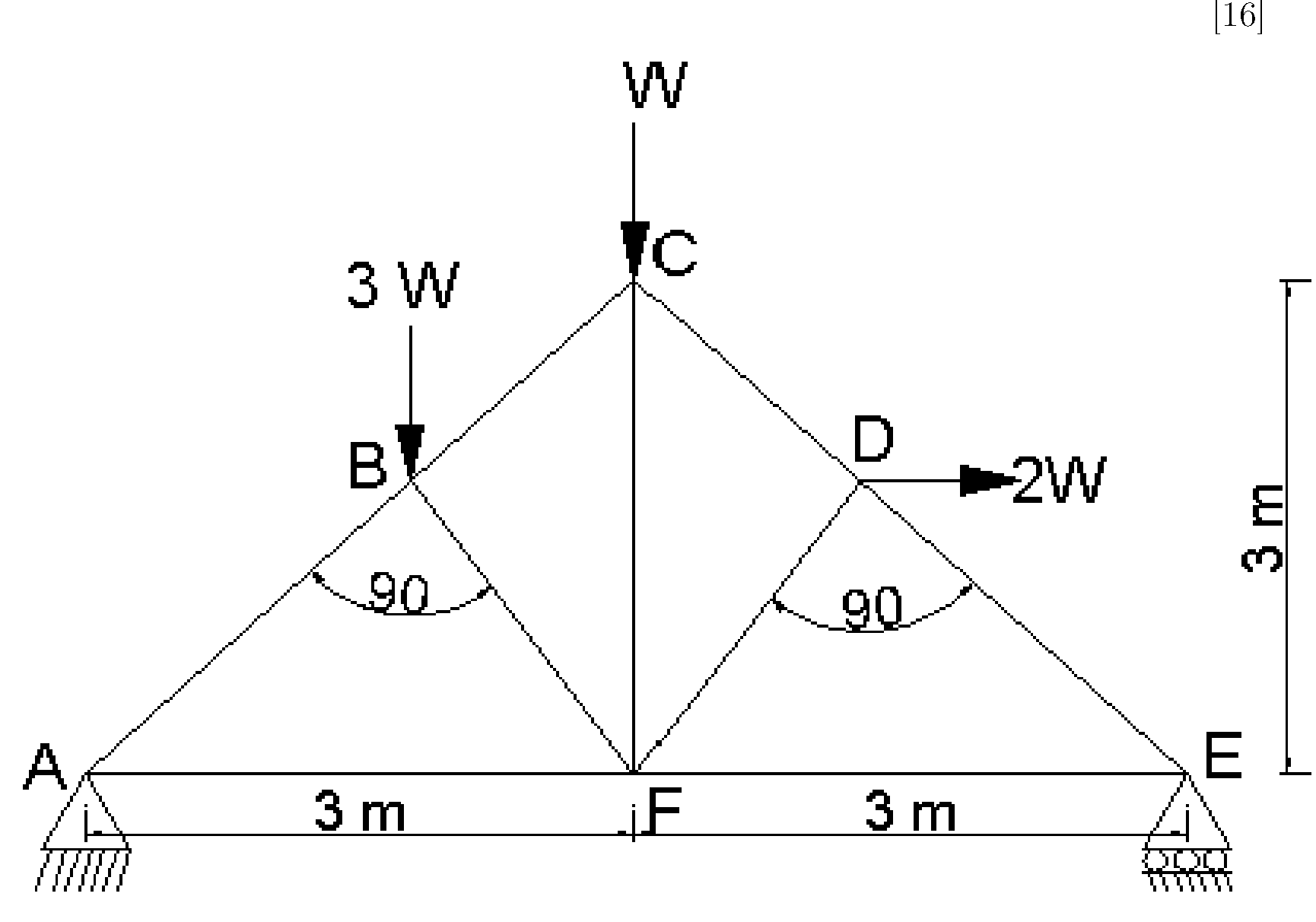 |
|
Figure 5 |
(a) The motion of a particle is given by the relation x = t2 - (t - 3)2 where x and t are expressed in metres and records, respectively. Determine:
6.
i. When the acceleration is zero
ii. The position and velocity of the particle at that time.
(b) The motion of a particle is defined by the relation x = t2 - (t - 1)3 when x and t are expressed is m and sec, respectively. Determine
i. the two positions at which the velocity is zero
ii. the total distance traveled by the particle from t = 0 to t = 2s. [8+8]
7. (a) A particle which moves in rectilinear translation is acted upon by a resultant
force R.
i. Give the form of the impulse-momentum equation for the particle
ii. What is the linear momentum of the particle?
iii. What are the units of linear momentum?
iv. What is the graphical interpretation of an impulse?
(b) Give the equation for the conservation of linear momentum of two particles which move in rectilinear translation. What is significant limitation of the equation. [8+8]
8. The central deflection of a simply supported beam with a central point load is given by S = PL3 / 48EI. Where L = 5 M, E = 2 x105 N/mm2, I = 1.73 x 10-5 m4. The beam is of uniform cross section with a static load P. Determine
(a) equivalent spring constant of the beam
(b) the frequency of vibration of a 60kg block attached to the centre of the beam. Neglect the mass of the beam and assume that the load remaining in contact with the beam. [16]
I B.Tech Supplementary Examinations, November 2009 INTRODUCTION TO AEROSPACE ENGINEERING (Aeronautical Engineering)
Time: 3 hours Max Marks: 80
Answer any FIVE Questions All Questions carry equal marks i i i i i
1. (a) Explain the working principle of turbofan engine. Give the advantages over
other types.
(b) Explain about the Principle of Ramjet engine. [8+8]
2. Explain the purpose of servo unit in the power operated control system. [16]
3. (a) What are the possible causes for an airplane to fly.
(b) How the lift is generated in the Airplane wing? Explain how it is reduced by induced drag. [8+8]
4. (a) What is the fail-safe feature in aircraft construction?
(b) Discuss the advantages of bonded construction? [8+8]
5. Discuss in detail about the inventors of early jet engines. [16]
6. Consider an airfoil (the cross section of a wing) in a flow of air, where far a head (upstream) of the airfoil, the pressure, velocity and density are 2116 ff/ft2, 100 mi/h, and 0.002377 slug/ft3 respectively. At a given point A on the airfoil, the pressure is 2070 ff/ft2. What is the velocity at point A? [16]
7. With the series of diagrams, explain the static and dynamic responses of an aircraft after it has been disturbed by a small force. [16]
8. Explain in detail about a communications satellite. [16]
iiiii
I B.Tech Supplementary Examinations, November 2009 INTRODUCTION TO AEROSPACE ENGINEERING (Aeronautical Engineering)
Time: 3 hours Max Marks: 80
Answer any FIVE Questions All Questions carry equal marks
1. (a) Illustrate the elements of an aircraft structures?
(b) Explain the wing structure of an aeroplane with neat diagram. [8+8]
2. (a) If trim tab on a rudder is moved to the right, what effect does it have on the
flight of the aircraft?
(b) Explain the operation of balance tab? [8+8]
3. (a) What are the possible causes for an airplane to fly.
(b) How the lift is generated in the Airplane wing? Explain how it is reduced by induced drag. [8+8]
4. (a) What is the purpose of drag and anti-drag wires?
(b) Define ribs. [10+6]
5. With the help at a sketch, describe the three primary sequential phases of a space mission. [16]
6. (a) Define boundary layer. Explain. Reynolds number.
(b) Discuss in detail about the various types of drag in an airplane and methods of minimising the drag. [6+10]
7. What is the cause of aileron reversal and explain the methods to rectify them. [16]
8. Assume that you wish to place in orbit a satellite that always remains directly above the some point on the earth's equator. What velocity and attitude must the satellite have at the instant of burnout of the rocket booster? [16]
I B.Tech Supplementary Examinations, November 2009 INTRODUCTION TO AEROSPACE ENGINEERING (Aeronautical Engineering)
Time: 3 hours Max Marks: 80
Answer any FIVE Questions All Questions carry equal marks
1. (a) Define aerodynamics as a component of fluid dynamics.
(b) Explain about on skin friction in detail. [6+10]
2. Draw typical lateral control system name the components and explain their functions? [16]
3. (a) How is skin friction caused? Why is the skin friction becoming greater impor
tance recently.
(b) Explain what happens in the boundary layer? [8+8]
4. (a) Name the principal load-carrying members in a light aircraft wing.
(b) Define spar. [10+6]
5. With the help at a sketch, describe the three primary sequential phases of a space mission. [16]
6. With the aid of figures, explain as how it is possible to have wings of the same area with different type of aspect ratios. [16]
7. (a) Explain in detail with the help of a figure directional static stability.
(b) Explain in detail with the help of a figure lateral static stability. [8+8]
8. Explain the anatomy of a space mission. [16]
I B.Tech Supplementary Examinations, November 2009 INTRODUCTION TO AEROSPACE ENGINEERING (Aeronautical Engineering)
Time: 3 hours Max Marks: 80
Answer any FIVE Questions All Questions carry equal marks
1. (a) Describe about Leonardo da Vincis Ornithopter?
(b) Explain the performance of the glider made by Percy Pilcher. [8+8]
2. Draw typical longitudinal control system and explain the function of each component? [16]
3. (a) Define pressure, temperature and density altitudes?
(b) Explain the relation between e Geopotential and Geometric altitudes? [6+10]
4. (a) Write notes on frames and stringers.
(b) Illustrate monocoque construction of fuselage with neat sketch. [8+8]
5. With the help of schematic rocket engine, examine its basic characteristics. [16]
6. In a test on an aerofoil section the moment coefficient about the leading edge was found to be -0.005 at zero lift. At 6o angle of attack the moment coefficient about the leading edge was - 0.240 and the lift and drag co-efficient were 0.90 and 0.045 respectively. Find the position of the aerodynamic centre of this aerofoil section.
[16]
7. (a) Discuss in detail about control tabs and your evaluation.
(b) What is the role of a tail plane during horizontal flight? [8+8]
8. Explain in detail about a communications satellite. [16]
I B.Tech Supplementary Examinations, November 2009 BASIC ELECTRICAL AND ELECTRONICS ENGINEERING
(Bio-Technology)
Time: 3 hours Max Marks: 80
Answer any FIVE Questions All Questions carry equal marks
k k k k k
1. Two resistors RI = 2500 Q and R2 = 4000 Q are joined in series and connected to a 100 V supply. The voltage drop across R\ and R2 are measured successively by a volt meter having a resistance of 50000 Q. Find the sum of the readings. [16]
2. With neat sketch explain the magnetisation characteristics of dc shunt generator. Also explain how to find Rc and Nc. [16]
3. Justify the necessity of controlling torque in indicating instruments. Discuss the various methods of producing the same. Compare them. [16]
4. Discuss with circuit and waveforms for full-wave rectifier. [16]
5. Explain the Ebers - Moll equation of a PNP transistor taking hole and electron current into consideration. [16]
6. Explain in detail the frequency response of RC coupled amplifier. [16]
7. A Hartley oscillator is designed with Li = 2mH, L2 = 20H and a variable capacitance. Determine the range of capacitance values is the frequency of oscillation is varied from 2050 KHz to 3050 KHz. [16]
8. (a) Realize the following function using 8:1 multiplexer. f (A, B, C, D) = ( 0,
3, 5, 6, 9, 10, 12, 15).
(b) Implement a full subtractor using NAND gates? [16]
I B.Tech Supplementary Examinations, November 2009 BASIC ELECTRICAL AND ELECTRONICS ENGINEERING
(Bio-Technology)
Time: 3 hours Max Marks: 80
Answer any FIVE Questions All Questions carry equal marks
1. A circuit consisting of three resistances 12 Q 18Q and 36 Q respectively joined in parallel is connected in series with a fourth resistance. The whole circuit is applied with 60V and it is found that the power dissipated in the 12 Q resistor is 36 W. Determine the value of the fourth resistance and the total power dissipated in the circuit. [16]
2. Explain the principle of operation of synchronous machine. [16]
3. Classify different types of measuring instruments and give one example for each.
[16]
4. Draw and explain V-I characteristics ofa zener junction and show how a zener diode acts as voltage regulator. [16]
5. A silicon transistor with 0 = 80 is used in self biasing arrangement with Vcc VCC = 15V, Rc = 4.7 kQ The operating point Q is at VCE = 8.2V, IC = 1.2mA. Find the values of Ri, R2, and RE. [16]
6. A single stage class A amplifier Vcc= 20V, VCEq= 10V, ICq = 600mA
and collector load resistor RL The AC output current varies by 300mA with the input signal. Determine:
(a) The power supplied by the dc source to the amplifier circuit.
(b) AC power developed across the load resistor.
(c) AC power consumed by the load resistor.
(d) DC power delivered to the transistor.
(e) Overall efficiency.
(f) DC power wasted in the transistor collector.
(g) Collector efficiency. [16]
7. (a) Draw an OP-Amp circuit to implement the following expression: V0 = V1 +
V2 - [V3 + V4 + 2].
(b) Draw the equivalent circuit of practical OP - Amp and state its characteristics.
[16]
8. (a) Compare the performance of synchronous circuits with Asynchronous circuits
in relation to
i. Races.
ii. hazards.
(b) Give the steps for analyzing the asynchronous sequential circuits.
[16]
I B.Tech Supplementary Examinations, November 2009 BASIC ELECTRICAL AND ELECTRONICS ENGINEERING
(Bio-Technology)
Time: 3 hours Max Marks: 80
Answer any FIVE Questions All Questions carry equal marks
1. A balanced delta connected load of (8 + j7) Q / phase is connected to a 3 phase, 230V supply. Find the line current, power factor, power, reactive volt-amperes and total volt- amperes. [16]
2. Explain the load characteristics of dc shunt motor and series motor. [16]
3. Justify the necessity of controlling torque in indicating instruments. Discuss the various methods of producing the same. Compare them. [16]
4. What is a zener diode? Draw the equivalent circuit of an ideal zener in the breakdown region. Why is zener diode used as a voltage regulator? [16]
5. Sketch a typical drain characteristic for an N-channel JFET. Explain the shape of the characteristic and identify the regions. [16]
6. Explain the operation of double tuned amplifier with a neat sketch and obtain an expression for its gain band width product. [16]
7. A Hartley oscillator is designed with Li = 2mH, L2 = 20H and a variable capacitance. Determine the range of capacitance values is the frequency of oscillation is varied from 2050 KHz to 3050 KHz. [16]
8. (a) Realize the following function using 8:1 multiplexer. f (A, B, C, D) = E ( 0,
3, 5, 6, 9, 10, 12, 15).
(b) Implement a full subtractor using NAND gates? [16]
I B.Tech Supplementary Examinations, November 2009 BASIC ELECTRICAL AND ELECTRONICS ENGINEERING
(Bio-Technology)
Time: 3 hours Max Marks: 80
Answer any FIVE Questions All Questions carry equal marks
1. In the circuit shown in the figure 1, find E\, E2 and I when the power dissipated in 5 ohms resistor is 125W. [16]
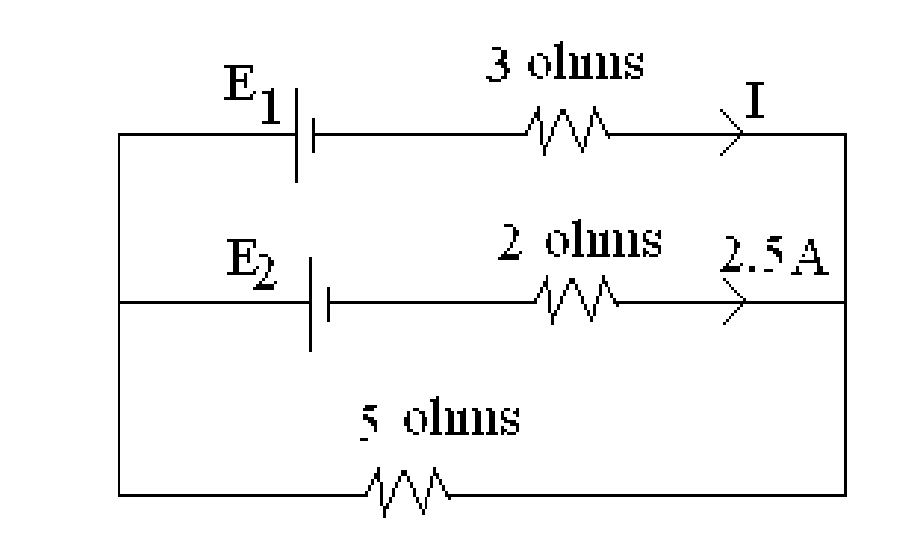 |
|
Figure 1 |
2. Describe the principle of operation of single phase induction motor using capacitor. Draw the circuit and phasor diagram. [16]
3. Justify the necessity of controlling torque in indicating instruments. Discuss the various methods of producing the same. Compare them. [16]
4. What is a zener diode? Draw the equivalent circuit of an ideal zener in the breakdown region. Why is zener diode used as a voltage regulator? [16]
5. Data sheet for a JFET indicates that Dss = 12mA and Vcs(off) = -4V. Determine the drain current for a VGS = -2V. [16]
6. A single tuned class A amplifier has a transform coupled load of 8Q. If the transformer turns ratio (Ni/N2) is 10, find the maximum power output delivered to the board. Take the zero signal collector current of 500 mA. [16]
7. Derive an expression for voltage gain, current gain output and input impedance of voltage series feedback amplifiers. [16]
8. (a) Discuss the advantages of reflected codes. [6]
(b) Explain the salient features of excess 3 code and show how addition and subtraction operation can be performed in excess 3 code. [10]
1 of 1
(a) Write down the assumptions made while finding out the forces in various members of a framed structure.
(b) Find the forces in all the members of a structure shown in figure 5b. [6+10]
A force F with a magnitude of 150 N is applied at the origin O of the axes x, y and z as shown in Figure 2. The line of action of F passes through a point A whose co-ordinates are 2 m, 4 m and 6 m. Determine
(a) the x, y, and z scalar components of F
(b) the projection of F on x-y plane, and
(c) the projection of F along the line OB. [16]
|
Attachment: |
| Earning: Approval pending. |
